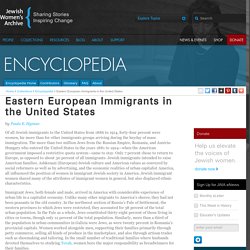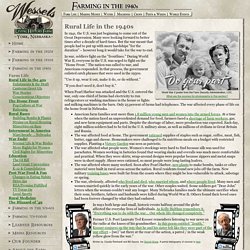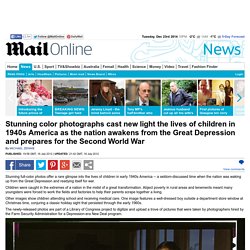

America's Best History U.S. Timeline, 1940-1949. Eastern European Immigrants in the United States. Of all Jewish immigrants to the United States from 1886 to 1914, forty-four percent were women, far more than for other immigrants groups arriving during the heyday of mass immigration.

The more than two million Jews from the Russian Empire, Romania, and Austria-Hungary who entered the United States in the years 1881 to 1924—when the American government imposed a restrictive quota system—came to stay. Only 7 percent chose to return to Europe, as opposed to about 30 percent of all immigrants. Jewish immigrants intended to raise American families. Ashkenazi (European) Jewish culture and American values as conveyed by social reformers as well as by advertising, and the economic realities of urban capitalist America, all influenced the position of women in immigrant Jewish society in America. Jewish immigrant women shared many of the attributes of immigrant women in general, but also displayed ethnic characteristics.
The kitchen gave a special character to our lives: my mother’s character. Farm Life during the 1940s. Rural Life in the 1940s In 1941, the U.S. was just beginning to come out of the Great Depression.

Many were looking forward to better times after a decade of hard times. But the war meant that people had to put up with more hardships "for the duration" – however long it would take for the war to end. In war, soldiers fight on the "frontlines. " During World War II, everyone in the U.S. was urged to fight on the "Home Front. " "Use it up, wear it out, make it do, or do without. " "If you don't need it, don't buy it. " When Pearl Harbor was attacked and the U.S. entered the war, only one-third of farms had electricity to run refrigerators or washing machines in the house or lights and milking machines in the barn.
American farm families sent more than 1.8 million young men and women into the armed forces. Written by Claudia Reinhardt and Bill Ganzel, the Ganzel Group. Jewish Americans - History, European life, Immigration waves, Settlement patterns, Acculturation and Assimilation. Overview Jews represent a group of people rather than a distinct race or ethnicity.

Although Jews originally came from the Middle East, many races and peoples have mixed together in Jewish communities over the centuries, especially after the Jews were forced out of Palestine in the second century C.E. What binds the group together is a common Jewish heritage as passed down from generation to generation. For many Jews, the binding force is Judaism, a term usually referring to the Jewish religion but sometimes used to refer to all Jews. There are, however, Jewish atheists and agnostics, and one does not have to be religious to be Jewish. Most Jews consider the State of Israel the Jewish homeland. Although Jews comprise less than three percent of the American population, Jews have generally had a disproportionately larger representation in American government, business, academia, and entertainment. After Abraham, the Hebrews were led by Abraham's son Isaac, then by Isaac's son Jacob.
Library of Congress color photos show American children in the 1940s. By Michael Zennie Published: 19:58 GMT, 16 July 2012 | Updated: 21:42 GMT, 16 July 2012 Stunning full-color photos offer a rare glimpse into the lives of children in early 1940s America -- a seldom-discussed time when the nation was waking up from the Great Depression and readying itself for war.

Children were caught in the extremes of a nation in the midst of a great transformation. Abject poverty in rural areas and tenements meant many youngsters were forced to work the fields and factories to help their parents scrape together a living. Other images show children attending school and receiving medical care. The newly-released photos are part of a Library of Congress project to digitize and upload a trove of pictures that were taken by photographers hired by the Farm Security Administration for a Depression-era New Deal program. Race relations: Black children did not fare well during this era, if these photos are to be an guide. But an urban setting doesn't guarantee prosperity.